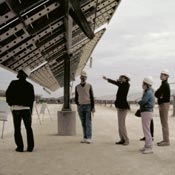Austin Energy shines bright with largest PV farm in Lone Star State
 Last week Austin Energy, the largest municipal utility in Texas, asserted its position among the leaders at the solar barn dance of Texas when it unveiled and commissioned a new, 30-megawatt photovoltaic plant. It’s the largest photovoltaic farm in the Lone Star State and the first utility-scale photovoltaic farm that the utility is buying power from.
Last week Austin Energy, the largest municipal utility in Texas, asserted its position among the leaders at the solar barn dance of Texas when it unveiled and commissioned a new, 30-megawatt photovoltaic plant. It’s the largest photovoltaic farm in the Lone Star State and the first utility-scale photovoltaic farm that the utility is buying power from.
Austin Energy is also one of the largest municipal utilities in the U.S. and is making strides toward becoming a greener energy supplier. The utility plans to source 35 percent of its electricity from renewable sources by 2020.
The 30-megawatt PV farm was built in Webberville, Texas, by Renewable Energy Systems and is owned by MetLife, according to Austin Energy spokesperson Ed Clark.
“We don’t own it,” he said. “We only pay for the power it produces.”
Austin Energy is buying the power produced at the plant through a 25-year power purchase agreement.
With the new solar farm and other sources of renewables it’s contracted to buy power from, the utility is well on its way to meeting the 2020 goal. It anticipates sourcing 25 percent of its energy from renewables by 2013, according to Clark.
The utility has plans to rely on solar and other sources of renewables.
“We will increasingly use other types of generation,” Clark said. “It will reduce the amount of coal power that we end up using.”
Those new sources of generation include a new 100-megawatt biomass-powered plant that is set to come online in summer 2012.
“We have a plan that calls for some additional utility-scale power-purchase agreements,” Clark said.
For instance, the utility also is sourcing a significant amount of power from wind. Clark said at this point the utility has up to 800 megawatts of wind under deployment.
The plan calls for up to 200 megawatts of solar by 2020. However, the actual number of megawatts of PV installed for Austin Energy will largely depend on the cost of such power.
“Texas has a nodal market,” Clark said. Under that design, the power produced and sold on the grid at any given moment is the least expensive available.



